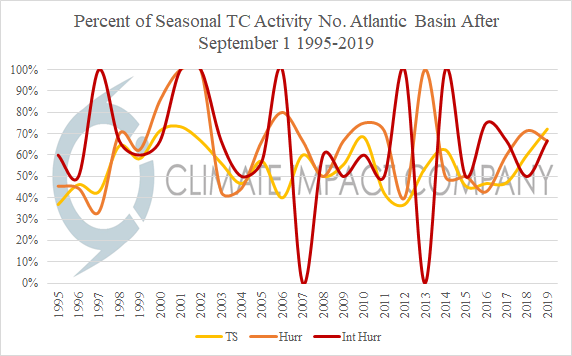
Only 2 Hurricanes So Far in North Atlantic. Can 10+ Still Occur As Seasonal Forecasts Indicate?
08/17/2020, 10:07 am EDTNorthern Hemisphere Sea Ice Extent 2nd Lowest on Record
09/20/2020, 1:55 pm EDT

Fig. 1-2: U.S. deep layer (10-200 CM) and shallow layer (0-10 CM) soil moisture anomalies. Intersecting deep/shallow dry zones are at risk of flash drought (if drought hasn’t already developed).
U.S. discussion: Classic flash drought is caused by presence of shallow (0-10 CM) dry soil conditions across a deep layer (10-200 CM) of soil moisture deficit which combines to cause an accelerated drought condition when a period of hot weather settles across the same area. Currently, there is widespread drought across the West and Southwest U.S. to the 4-Corners region and into Texas plus Iowa and New England. Areas not observing drought but could easily transition to a drought or flash drought due to the presence of dry soils in both the shallow and deep layers include the North-central U.S., Iowa to southern Minnesota into northern Illinois and parts of the Southeast U.S. (Fig. 1-2).
Last week’s anomalous heat (Fig. 3) centered on Iowa caused flash drought in that an area of drought already present intensified and the dry soils acted as a feedback to accelerate the intensity and duration of the hot weather episode. Fortunately, late season cool weather across the Great Plains (Fig. 4) and likely a wetter regime in the Southeast should prevent other flash drought areas east of the U.S. the remainder of the warm season 2020.


Fig. 3-4: U.S. temperature anomalies during last week’s Midwest heatwave and a cool forecast across the Central U.S. for the next 15 days.
Europe/Western Russia discussion: Deep layer soil moisture deficits were formidable in Ukraine earlier this year but wet and cool periods followed to erase much of that deficit. During late summer the deep layer soil moisture deficit has redeveloped and also includes South-central Russia (Fig. 5). Shallow soil moisture deficits have also developed and intensified across much of the Black Sea region to the Russia spring grains stretch (Fig. 6). Unlike the U.S. forecast which cools off the first half of September the dry zone in Southwest Russia stays dry and very warm (Fig. 7-8) which should accelerate drought and produce potential for flash drought in parts of this region in September.


Fig. 5-6: Europe and Western Russia deep layer (10-200 CM) and shallow layer (0-10 CM) soil moisture anomalies. Intersecting deep/shallow dry zones are at risk of flash drought (if drought hasn’t already developed).


Fig. 7-8: The GFS ENS indicates a very warm and dry pattern across the Black Sea region and vicinity the next 15 days.
